At the heart of Vietnamese culinary tapestry are Vietnamese herbs, which bring life to every dish with their vibrant flavors, aromatic fragrances, and healing properties. For centuries, these humble greens have shaped not just the taste but also the health benefits of Vietnamese cuisine. Join me, a proud Vietnamese, as we explore the extraordinary role of these herbs and uncover the secrets they hold in making our food so unique and beloved worldwide.
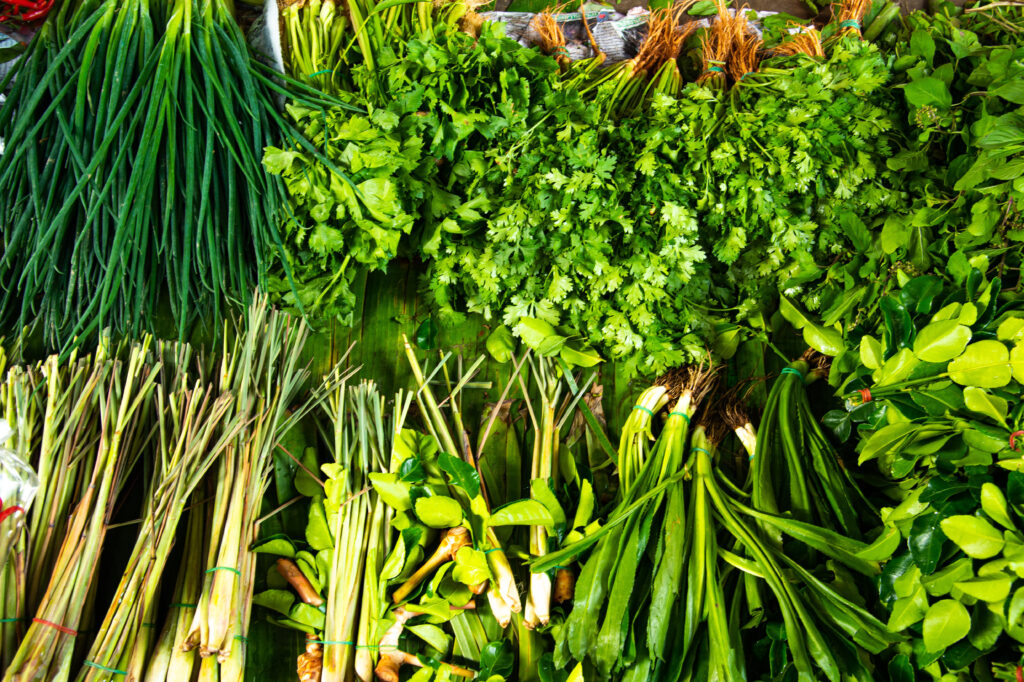
The Role of Vietnamese Herbs
Vietnamese herbs are the soul of Vietnamese cuisine, transforming dishes into aromatic masterpieces and embodying the essence of Vietnamese culture. For centuries, these fresh, vibrant herbs have been an integral part of every meal, enriching not only the flavor but also the health benefits of each dish. As a proud Vietnamese, sharing the fascinating world of Vietnamese herbs feels like inviting you into the heart of my country’s culinary heritage.
The magic of Vietnamese cuisine lies in its delicate balance of flavors—sweet, sour, salty, and spicy—all of which are elevated by the thoughtful use of herbs. Imagine the freshness of mint in a bowl of Pho, the zesty kick of Thai basil in Bun Cha, or the earthy aroma of perilla leaves wrapping a sizzling Banh Xeo. These herbs do not merely complement the dishes; they define them, adding layers of complexity and a sense of authenticity.
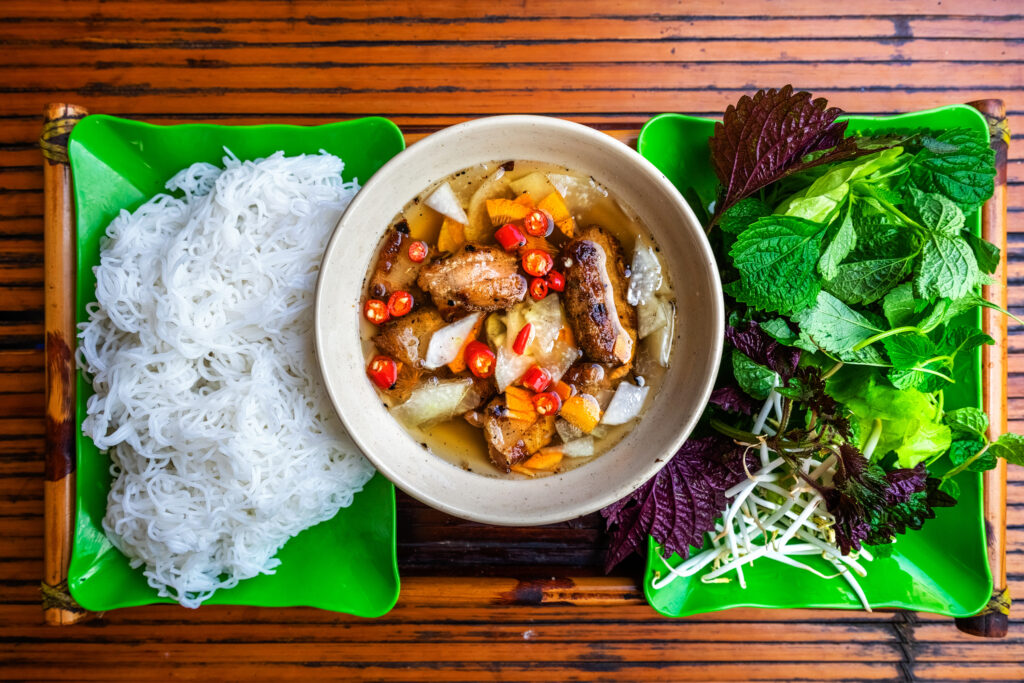
But what makes Vietnamese herbs so essential? Beyond their ability to tantalize the taste buds, they are a cornerstone of the health-conscious philosophy that defines Vietnamese cooking. These herbs are not just ingredients—they are natural remedies, packed with nutrients and healing properties that reflect the wisdom of our ancestors.
Have you ever wondered why Vietnamese food is celebrated as one of the healthiest cuisines in the world? The answer lies in its clever use of herbs. So, what herbs do Vietnamese use, and how do they shape this unique culinary identity? Let’s embark on a flavorful journey to discover the incredible role of Vietnamese herbs in both our cuisine and culture.
Vietnamese Herbs in Vietnamese Cuisine and the Art of Balance
Vietnamese cuisine is a harmonious symphony of flavors, textures, and aesthetics. What makes it stand out globally is not just the delicious dishes but the deep cultural philosophy and sensory appeal that underpin every meal. At its core lies the art of balance, where Vietnamese herbs play a starring role in achieving harmony and delighting the senses.
The Yin-Yang Philosophy in Vietnamese Cooking
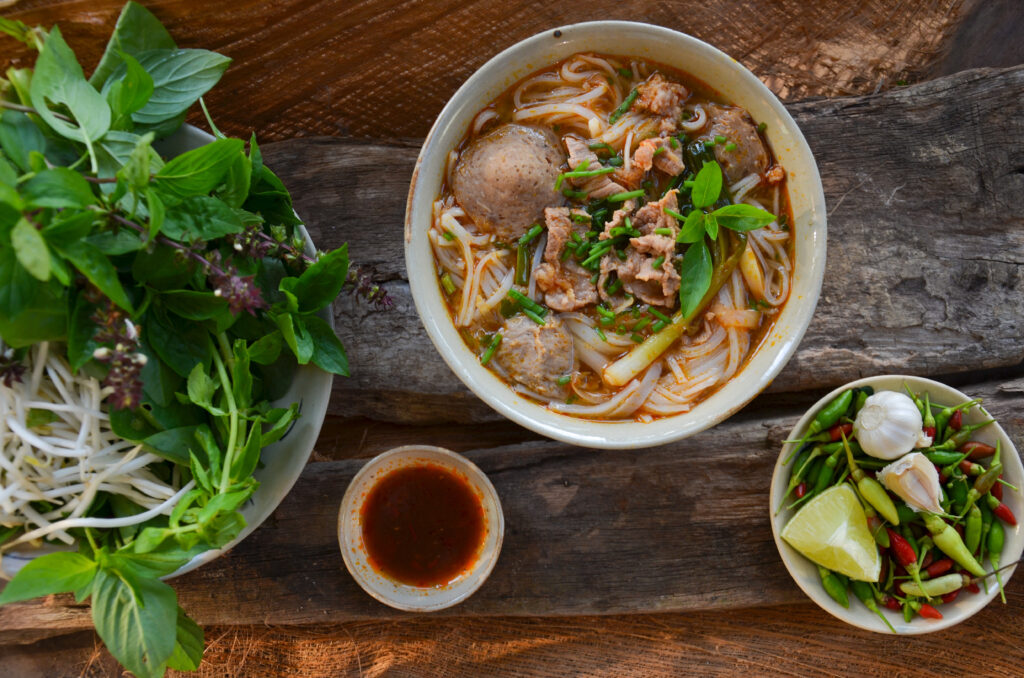
In Vietnamese cooking, the principle of yin and yang is deeply ingrained, reflecting a balance between opposing forces to promote health and well-being. This philosophy extends to ingredients, flavors, and even the energy of a dish. Herbs, with their fresh and vibrant characteristics, are essential in maintaining this balance.
For example:
- Pho, the iconic Vietnamese noodle soup, achieves equilibrium with its warm, savory broth (yang) paired with cool, fragrant herbs like coriander, Thai basil, and spring onions (yin).
- Goi Cuon (fresh spring rolls) combine cooling mint and lettuce (yin) with warm, savory shrimp or pork (yang), wrapped in soft rice paper.
- Bun Cha, a dish of grilled pork with rice noodles, balances hot grilled meat (yang) with a platter of fresh greens like perilla, Vietnamese coriander, and fish mint (yin).
This yin-yang philosophy doesn’t just elevate flavor; it ensures that the dish complements the body’s internal balance, making the meal not only satisfying but nourishing.
How Vietnamese Cuisine Engages the Senses
Vietnamese food is a sensory feast that goes beyond taste. It’s designed to engage all five senses, creating an unforgettable dining experience. Here’s how:
- Sight: Vibrant green herbs are the visual highlight of many dishes, enhancing the aesthetic appeal and signaling freshness.
- Smell: Aromatic herbs like lemongrass, mint, and Thai basil tantalize the nose, promising bold flavors even before the first bite.
- Taste: The complex interplay of sweet, sour, salty, and spicy flavors is enriched by the delicate notes of herbs like coriander and Vietnamese balm.
- Touch: Herbs bring texture to a dish—crisp lettuce, soft mint leaves, and velvety perilla add layers to every bite.
- Hearing: In dishes like Banh Xeo (Vietnamese sizzling crepes), the sound of fresh herbs being torn and added to the dish complements the crackle of the crepe.
Herbs are more than just ingredients; they are vital contributors to this sensory harmony, making Vietnamese cuisine a multi-dimensional experience that lingers in the memory long after the meal is over.
Next, we’ll explore why Vietnamese food is inseparable from its rich array of herbs and the cultural significance behind their ubiquitous presence.
What Are Vietnamese Herbs?
Vietnamese herbs are a cornerstone of the country’s culinary heritage, celebrated for their freshness, versatility, and health benefits. These fragrant leaves and tender stems are more than just garnishes; they are integral to the identity of Vietnamese cooking, shaping the flavors and character of countless dishes.
Definition of Vietnamese Herbs in Cooking
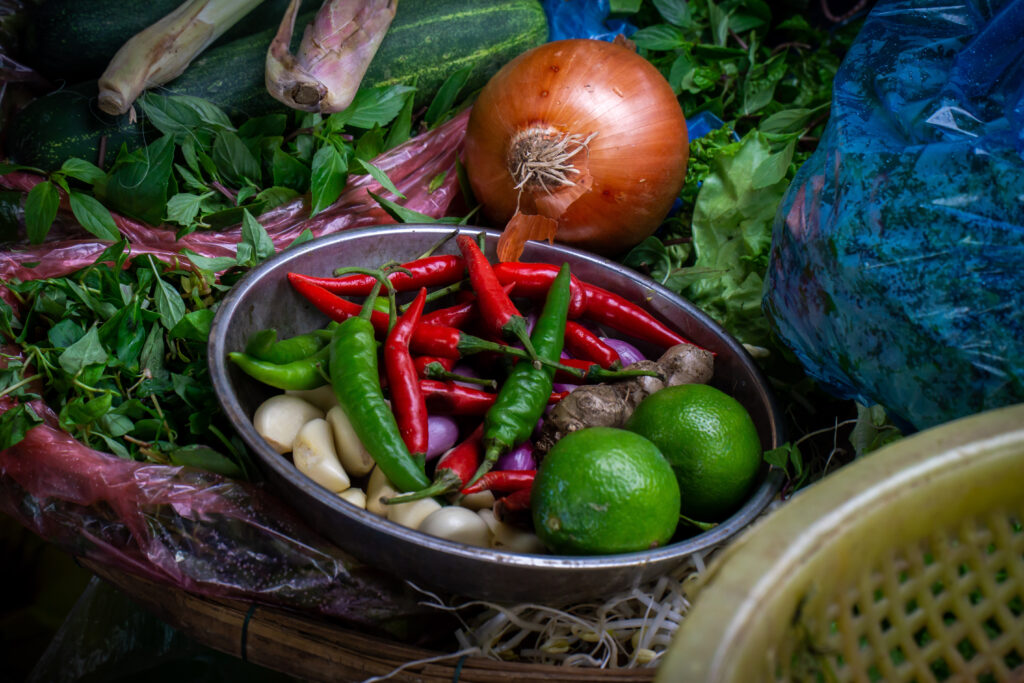
In Vietnamese cuisine, herbs are not merely a finishing touch—they are essential ingredients that define the essence of a dish. Herbs like Thai basil, coriander, and Vietnamese mint are used generously, often as a primary flavor component rather than a subtle accent. Their presence in every meal reflects the Vietnamese commitment to fresh, natural ingredients and harmonious flavors.
While Western herbs—such as rosemary, thyme, and oregano—are often used dried and in smaller quantities, Vietnamese herbs are predominantly consumed fresh and in abundance. These herbs are carefully selected for their ability to enhance the taste and aroma of dishes while also offering health benefits. They embody a philosophy of holistic nourishment, blending culinary artistry with medicinal wisdom.
Types of Vietnamese Herbs in Vietnamese Cuisine
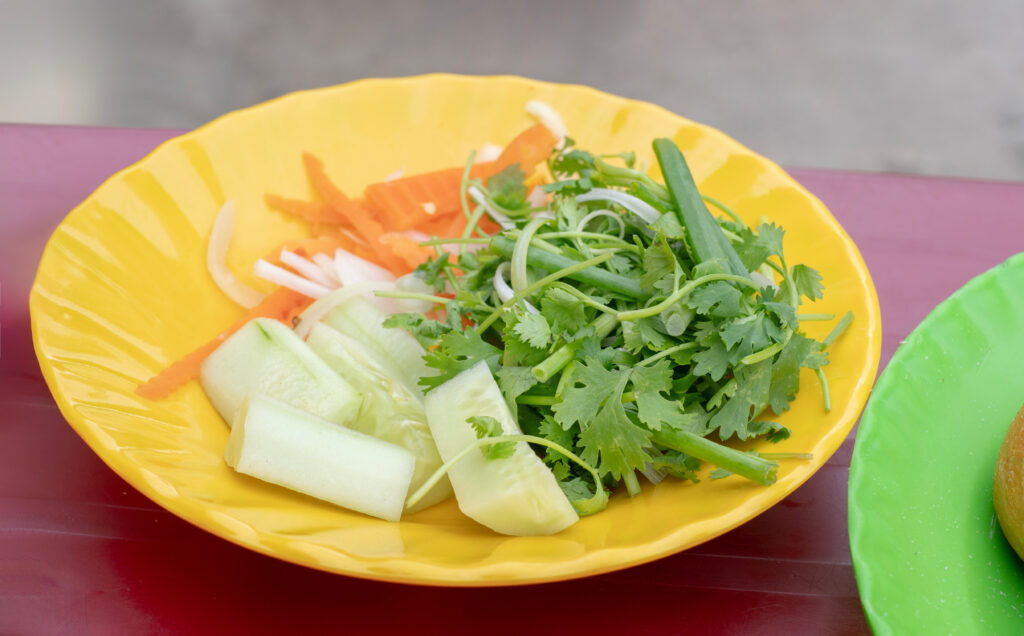
Vietnamese herbs can be grouped into three main categories based on their culinary and medicinal uses:
Leafy Greens
These herbs are widely used in Vietnamese cooking, often served raw as accompaniments or wrapped in dishes:
- Coriander (Ngò rí): A fragrant herb with a citrusy aroma, often used in soups, salads, and rice dishes.
- Mint (Bạc hà): Fresh and cooling, mint is a favorite for salads, spring rolls, and garnishing noodle soups.
- Lettuce (Xà lách): Often used as a base for wraps and rolls, providing a crisp texture.
Aromatic Herbs
These herbs provide bold flavors and distinct aromas that elevate Vietnamese dishes:
- Thai Basil (Húng quế): Known for its spicy and peppery notes, Thai basil is a staple in Pho and stir-fries.
- Vietnamese Coriander (Rau răm): Slightly spicy and lemony, it pairs perfectly with seafood and salads.
- Piper Lolot (Lá lốt): With its unique earthy aroma, Piper Lolot is often used in grilled dishes like Bo La Lot (grilled beef wrapped in betel leaves).
Medicinal Herbs
Many Vietnamese herbs are prized for their therapeutic properties, making them indispensable in both cooking and traditional medicine:
- Perilla (Tía tô): Known for its purple-tinged leaves, perilla is used in soups and salads to alleviate colds and improve digestion.
- Pennywort (Rau má): Frequently juiced or added to soups, pennywort is celebrated for its cooling properties and ability to detoxify the body.
- Fish Mint (Diếp cá): While its strong fishy aroma may be polarizing, fish mint is valued for its antibacterial properties and is often served with pancakes and salads.
Each herb carries its own flavor profile, nutritional value, and cultural significance. Together, they weave a tapestry of taste and tradition that is uniquely Vietnamese. In the next section, we’ll delve into why Vietnamese cuisine is inseparable from its vibrant array of herbs and how they enhance both flavor and health.
Why Does Vietnamese Food Use So Many Vietnamese Herbs?

Vietnamese food is synonymous with its abundant use of fresh herbs, a hallmark that distinguishes it from other global cuisines. These herbs are not just an afterthought but a deliberate and integral part of every dish. Their inclusion serves multiple purposes, from enhancing flavors to promoting health, rooted deeply in Vietnamese culinary traditions.
Vietnamese Herbs Enhances Flavor and Sensory Experience
One of the primary reasons Vietnamese food incorporates so many herbs is their unparalleled ability to elevate a dish’s overall sensory experience.
- Aroma: The fragrant notes of herbs like Thai basil, cilantro, and mint bring a fresh and vibrant aroma to dishes, engaging the senses even before the first bite. Imagine a bowl of Pho topped with freshly chopped cilantro and Thai basil—its aroma alone is enough to transport you to a bustling Vietnamese kitchen.
- Texture: Herbs add a delightful variety of textures to Vietnamese dishes. For example, the crispness of lettuce in Banh Xeo or the tender, velvety leaves of perilla in a grilled pork roll contrast beautifully with the main ingredients, creating a dynamic eating experience.
- Taste: The flavor profile of Vietnamese food is a delicate balance of sweet, salty, sour, and spicy, with herbs playing a crucial role in achieving this harmony. Herbs like Vietnamese coriander introduce a spicy, citrusy note, while fish mint lends an earthy, unique taste that complements the other ingredients. Without herbs, many iconic dishes would lack their distinctive character.
Herbs also transform a simple dish into a multi-dimensional experience. For instance, the combination of freshly plucked herbs with the dipping sauce in Goi Cuon (Vietnamese fresh spring rolls) creates an explosion of flavors with every bite. Each herb is chosen carefully to add depth and nuance, making every meal an immersive sensory journey.
Vietnamese Herbs Have Medicinal and Health Benefits
Vietnamese cuisine is not just about taste—it’s a reflection of a holistic approach to health. Herbs are celebrated for their therapeutic properties and play a pivotal role in promoting well-being.
- Balancing the Body: Vietnamese cooking follows the principle of yin-yang balance, ensuring harmony between the ingredients and the body. Herbs like perilla are used to balance “hot” and “cold” foods, aiding digestion and enhancing the body’s equilibrium. For instance, Vietnamese coriander is paired with boiled duck eggs to harmonize the meal’s yin-yang composition.
- Preventing Illness: Many herbs used in Vietnamese food are rich in antioxidants, vitamins, and essential oils that contribute to a healthier immune system. Herbs like lemongrass and ginger are known for their anti-inflammatory and digestive properties, while pennywort is revered for its detoxifying effects.
- Culinary Medicine: Vietnamese culture views food as medicine, and herbs are often the first line of defense against ailments. Holy basil is used to relieve respiratory issues, while fish mint is believed to have antibacterial properties. These medicinal benefits are seamlessly woven into everyday meals, turning every dish into an act of self-care.
The use of herbs in Vietnamese food is more than just a culinary choice—it’s a reflection of the country’s deep respect for nature. For centuries, Vietnamese families have cultivated herb gardens, where fresh greens are plucked daily to be incorporated into meals. This practice not only ensures freshness but also honors the bond between humans and the earth.
Herbs are the unsung heroes of Vietnamese cuisine, enhancing its flavors while promoting a balanced and healthy lifestyle. Their ubiquity in Vietnamese food is a testament to the wisdom and ingenuity of this ancient culinary tradition. Without them, Vietnamese cuisine would lose much of its charm, richness, and identity.
Top 8 Popular Vietnamese Herbs
Vietnamese cuisine is a harmonious symphony of flavors, textures, and aromas, and at the heart of this culinary magic are its vibrant herbs. These herbs not only add freshness and flavor but also carry profound cultural and medicinal significance. Below, we delve deeper into the eight most popular Vietnamese herbs, exploring their unique roles in Vietnamese cooking and their benefits.
Coriander (Ngò)

- Flavor and Aroma: Coriander, with its distinct citrusy and slightly sweet aroma, is a staple in Vietnamese cuisine. Its light green leaves bring a refreshing taste to any dish, offering a perfect balance to richer flavors.
- Common Dishes: Coriander is indispensable in dishes like Pho, where it’s sprinkled on top for added aroma, Banh Mi, and Goi Cuon (fresh spring rolls). Its versatility also makes it a garnish for soups, salads, and stir-fries.
- Health Benefits: Packed with vitamins A, C, and K, coriander supports immune health, enhances digestion, and promotes skin health. It is also believed to help lower blood sugar levels. On the Lunar New Year, it’s a tradition in Vietnam to use coriander-infused water for cleansing, symbolizing renewal and good fortune.
Thai Basil (Húng Quế)
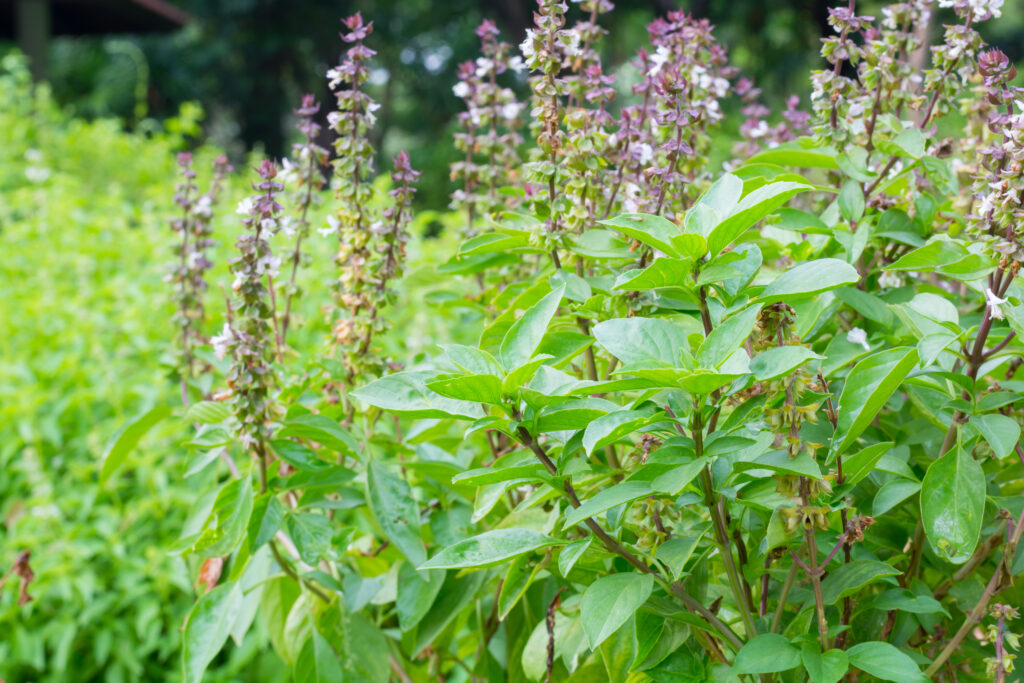
- Flavor and Aroma: Thai basil offers a robust, sweet flavor with a hint of spice and anise, making it a bold addition to many Vietnamese dishes.
- Common Dishes: Thai basil is essential in Pho, paired with bean sprouts and lime, as well as dishes like Bun Bo Hue (spicy beef noodle soup) and Banh Xeo (Vietnamese sizzling pancake). It’s also used in teas and refreshing beverages.
- Health Benefits: Renowned for its anti-inflammatory and antioxidant properties, Thai basil supports respiratory health, improves digestion, and boosts the immune system. In traditional medicine, it’s used to alleviate colds and fevers, making it both a culinary and medicinal treasure.
Vietnamese Coriander (Rau Răm)

- Flavor and Aroma: Known as “hot mint,” Vietnamese coriander has a peppery, citrusy, and slightly spicy flavor, giving dishes a distinctive kick.
- Common Dishes: Often served with seafood like clams and balut (fertilized duck eggs), it’s also a staple in chicken salads such as Goi Ga and noodle soups.
- Health Benefits: Vietnamese coriander aids digestion, reduces bloating, and is packed with antioxidants. It is also believed to inhibit cancer cell growth. This herb is a culinary star, enriching dishes with its unique flavor while promoting overall health.
Perilla (Tía Tô)

- Flavor and Aroma: Perilla boasts an earthy, minty flavor with hints of cinnamon, making it one of the more aromatic herbs in Vietnamese cooking.
- Common Dishes: Perilla enhances the flavors of Bun Rieu (crab noodle soup). It’s often eaten raw or used in soups to counteract fishy smells.
- Health Benefits: Perilla is a powerhouse of antioxidants and is known for its anti-inflammatory properties. It’s traditionally used to treat colds, fevers, and allergies. Its soothing aroma and taste make it a favorite in both cooking and herbal remedies.
Mint (Bạc Hà)
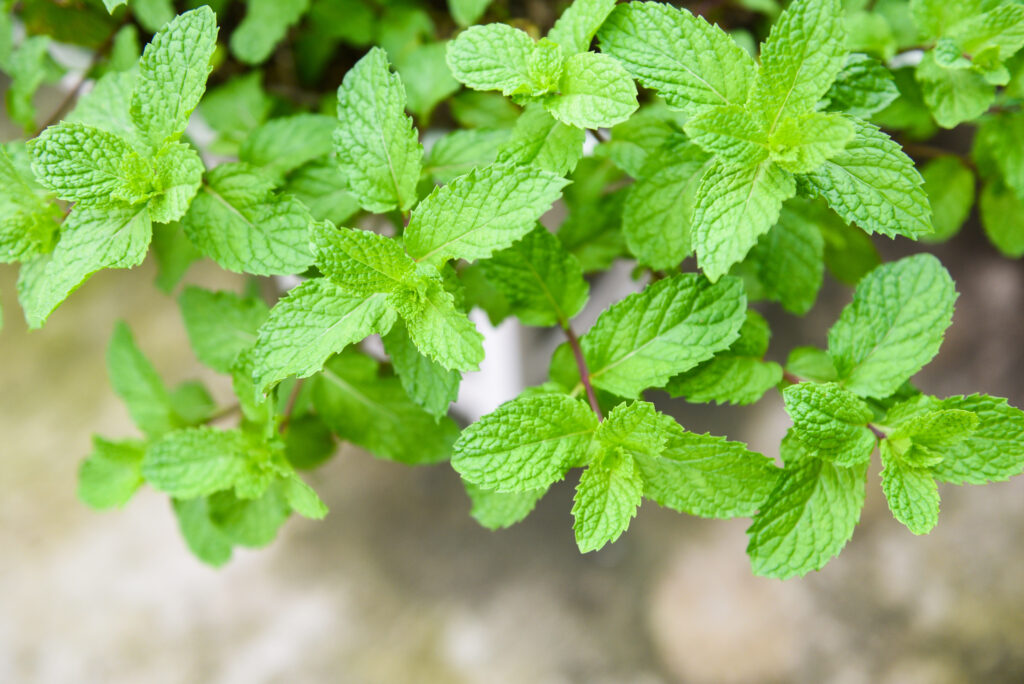
- Flavor and Aroma: Mint delivers a refreshing, cool sensation with a sweet, sharp aroma that awakens the palate.
- Common Dishes: This herb is a staple in Goi Cuon, and salads adding a burst of flavor to every bite. It’s also infused in teas and desserts.
- Health Benefits: Mint helps soothe digestion, reduce bloating, and alleviate headaches. Rich in vitamin A, it also supports eye health and night vision. Mint’s essential oil is often used to relieve nasal congestion and insect bites.
Pennywort (Rau Má)
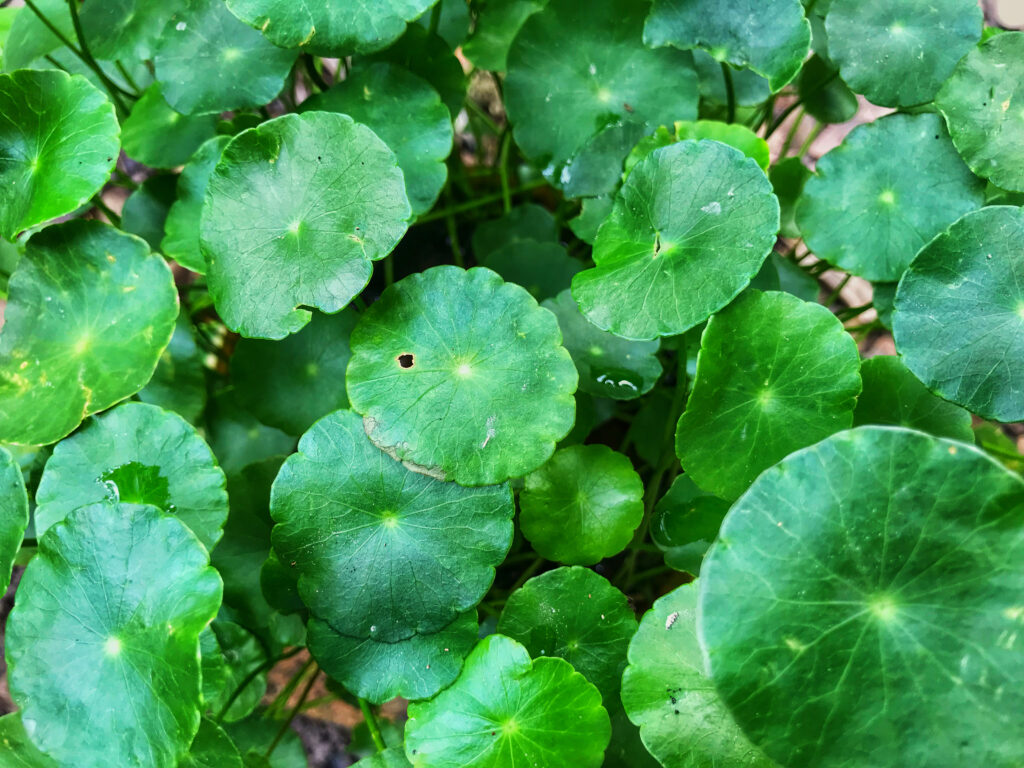
- Flavor and Aroma: Pennywort has a mild, grassy taste with a hint of sweetness, offering a fresh and earthy aroma.
- Common Dishes: Often juiced into a refreshing herbal drink, pennywort also appears in soups and salads. Popular dishes include Rau Má Salad, which is especially appreciated during Vietnam’s scorching summers.
- Health Benefits: Celebrated for its detoxifying properties, pennywort promotes skin health, improves circulation, and reduces stress. Traditional remedies often use it to treat inflammation, stomach issues, and urinary tract infections. Its cooling effect is particularly valued in hot weather.
Fish Lettuce (Diếp Cá)
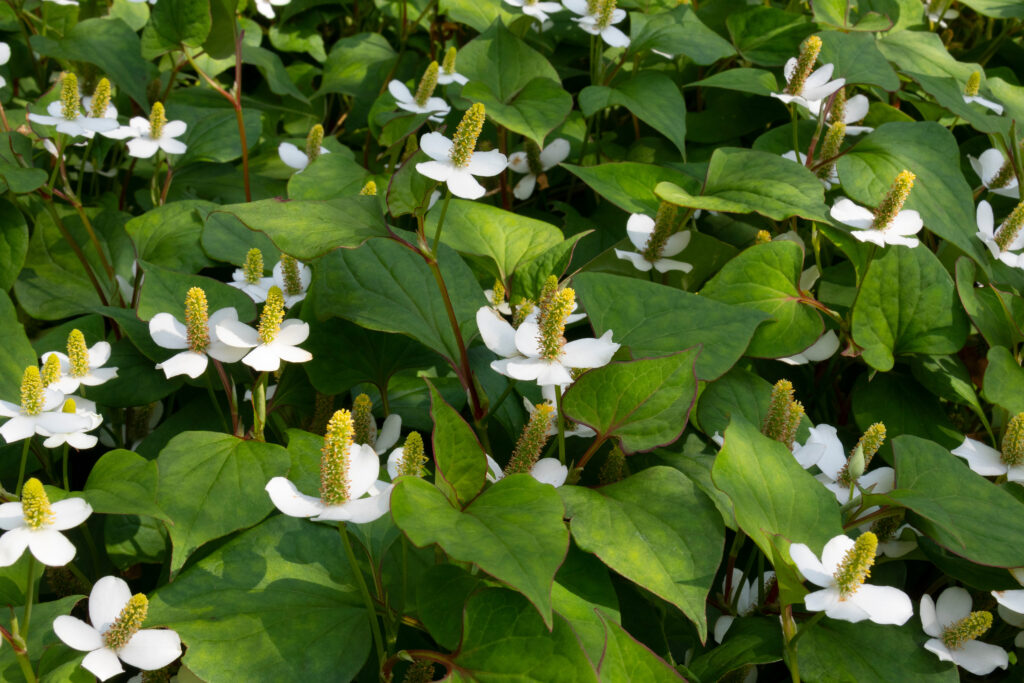
- Flavor and Aroma: True to its name, fish lettuce has a distinct fishy aroma, which can be an acquired taste for some but is adored by many for its unique flavor.
- Common Dishes: Served raw alongside Banh Xeo, Bun Dau Mam Tom (tofu with fermented shrimp paste), and salads, it adds a refreshing contrast to rich dishes.
- Health Benefits: Fish lettuce is known for its antibacterial and anti-inflammatory properties. It’s traditionally used to treat rashes, digestive issues, and respiratory ailments. Despite its strong aroma, its health benefits make it a cherished herb in Vietnamese cuisine.
Piper Lolot (Lá Lốt)
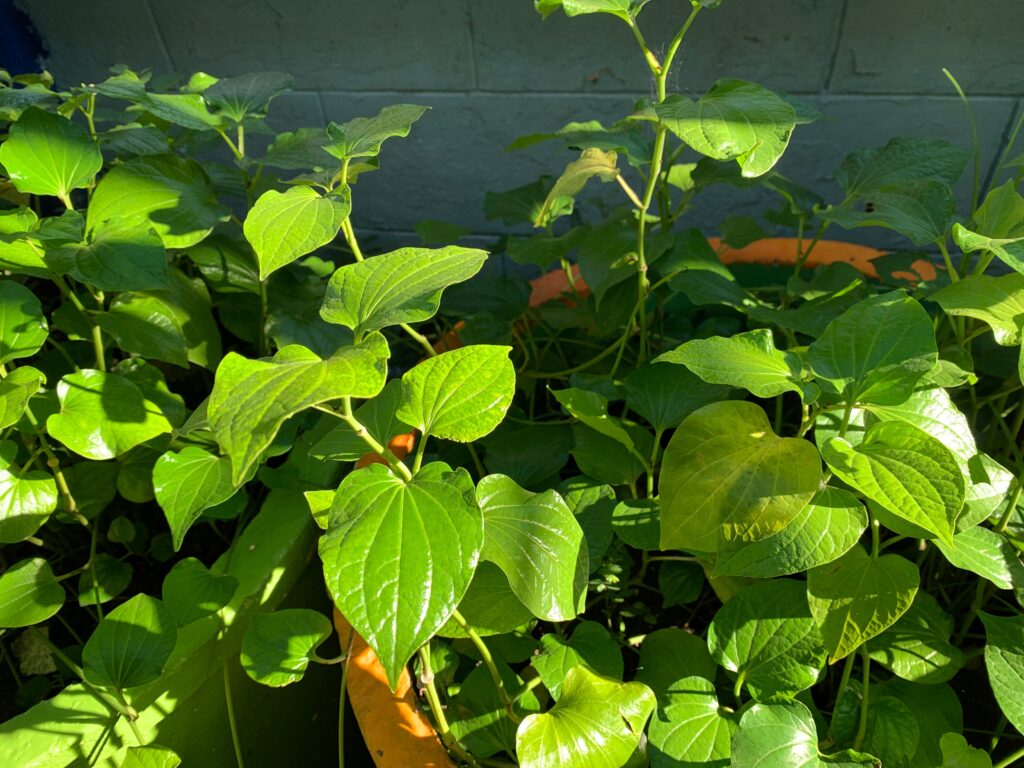
- Flavor and Aroma: Piper lolot has a warm, peppery flavor with a subtle smokiness, making it a flavorful addition to grilled dishes.
- Common Dishes: Best known for Bo La Lot (grilled beef wrapped in betel leaves), it’s also used in soups and stir-fries for its aromatic qualities.
- Health Benefits: This herb is valued for its ability to relieve joint pain, improve digestion, and alleviate headaches. Traditional remedies often use it to treat colds and other common ailments.
These eight Vietnamese herbs are more than just ingredients—they are the soul of the nation’s culinary identity. Each herb tells a story, from its role in balancing flavors to its profound health benefits. Exploring these herbs is like delving into Vietnam’s culture, history, and love for nature, making every dish not just a meal but an experience.
How to Eat Vietnamese Herbs Like a Local
Vietnamese herbs are more than just a garnish—they are essential to the flavor and identity of every dish. From street food stalls to family dinners, these vibrant greens play a pivotal role in Vietnamese cuisine. If you’re new to the world of Vietnamese herbs, this guide will help you savor them like a true local.
Vietnamese Herbs in Street Food
Vietnam’s street food culture is legendary, and herbs are at its heart, enhancing dishes with freshness and complexity. Here’s how herbs are woven into iconic Vietnamese street food:
- Pho: No bowl of Pho is complete without a side of fresh herbs like Thai basil, cilantro, and mint. These herbs are often added to the steaming broth, releasing their aroma and balancing the richness of the dish.
- Banh Xeo (Sizzling Pancakes): This crispy delight is wrapped in a bed of greens, including perilla, lettuce, and fish lettuce, creating a medley of textures and flavors with each bite.
- Goi Cuon (Fresh Spring Rolls): Herbs like mint, Vietnamese coriander, and chives are rolled into translucent rice paper alongside shrimp, pork, and vermicelli, making every roll a burst of freshness.
- Bun Cha (Grilled Pork and Noodles): Served with a platter of fresh herbs like perilla and Thai basil, diners can mix and match their greens to customize each bite of this Hanoi specialty.
Herbs are more than just accompaniments; they are indispensable elements that elevate street food to an art form.
Tips for Beginners to Vietnamese Herbs
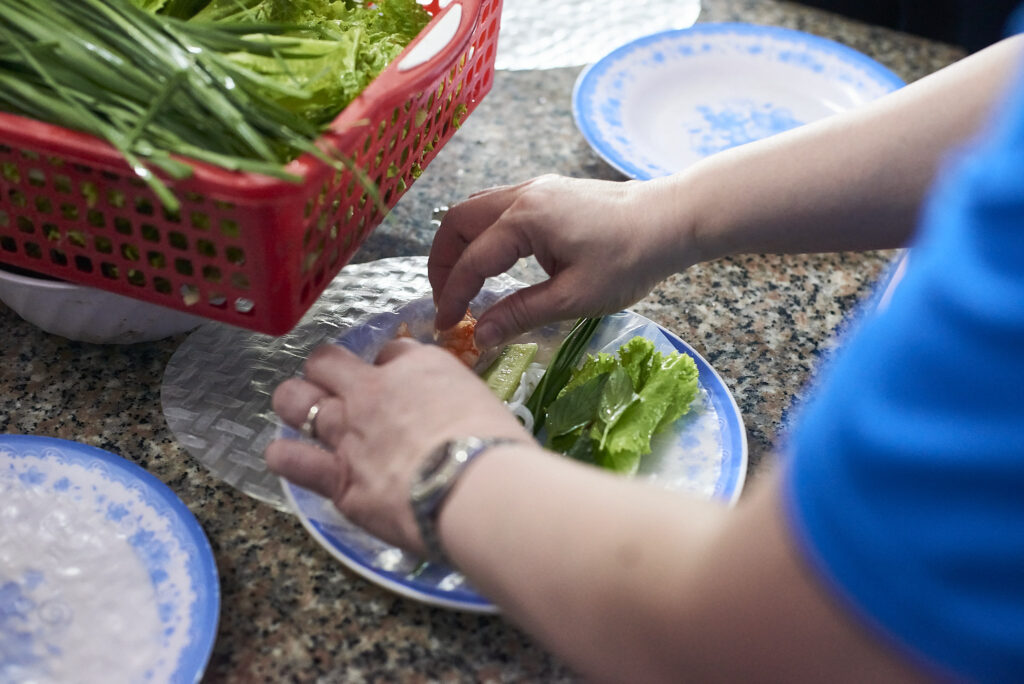
If you’re new to Vietnamese herbs, their bold flavors and aromas might feel overwhelming at first. Here are some tips to ease into the experience:
- Start Slowly: Begin with familiar herbs like mint and coriander, which are milder and more universally appealing. Gradually try more intense herbs like fish lettuce and piper lolot as you build your palate.
- Mix and Match: Experiment with different combinations of herbs in your dishes to find what suits your taste best. Vietnamese cuisine encourages personalization, so there’s no wrong way to enjoy them.
- Pair with the Right Dishes: Some herbs are better suited to specific dishes. For example, Thai basil shines in Pho, while perilla adds depth to Banh Xeo. Follow the locals’ lead to get the best flavor combinations.
- Don’t Be Afraid to Ask: If certain herbs aren’t to your liking, politely request your dish without them. For instance, you can say “không hành” (no spring onion) when ordering Pho.
By easing into the variety of Vietnamese herbs, you can discover their incredible contribution to the flavor and character of each dish.
Cultural Etiquette of Eating Vietnamese Herbs
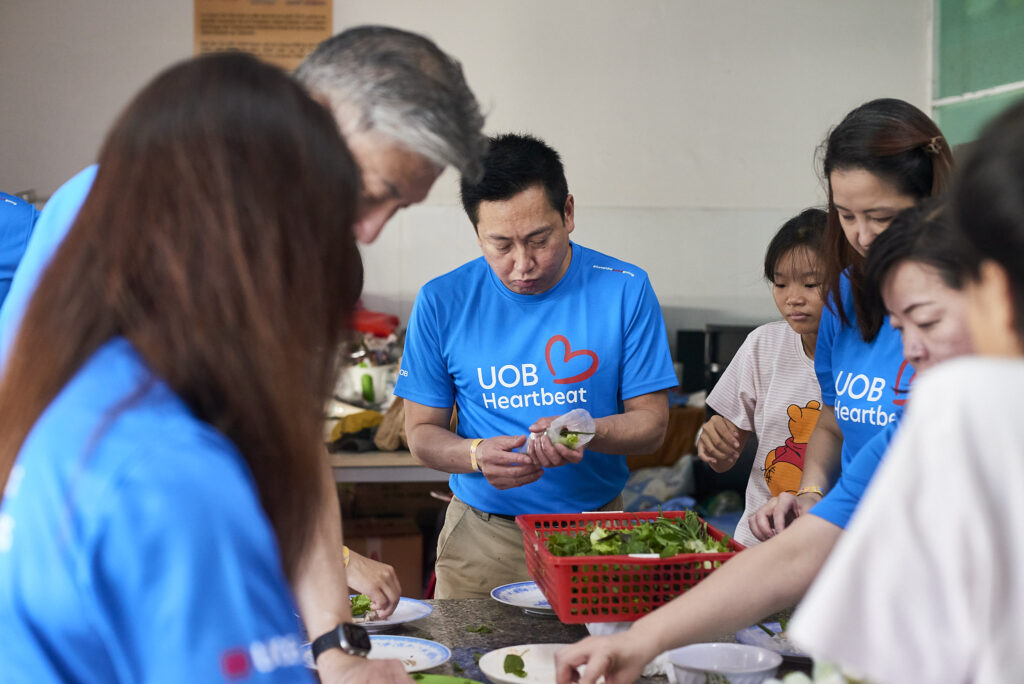
Eating herbs in Vietnam is not just about taste—it’s a cultural experience. Understanding the customs and etiquette surrounding herbs can enrich your journey:
- Sharing Meals: In Vietnam, meals are often shared family-style, with a communal platter of herbs placed at the center of the table. This encourages interaction and bonding among diners.
- Respect for Food: Vietnamese culture values respect for food and its preparation. Leaving herbs untouched on your plate might be considered wasteful, so take only what you plan to eat.
- Tailoring Your Dish: While personalization is welcome, it’s also polite to appreciate the chef’s intended flavor profile. Try the dish as served before making adjustments with herbs and condiments.
- Market Visits: If you have the chance, visit a local market to see the vibrant displays of fresh herbs. Engage with vendors to learn about the herbs they sell—it’s a great way to connect with the culture.
Herbs are not just ingredients in Vietnam; they are part of a deeper culinary and cultural tradition that reflects the nation’s love for balance, flavor, and community.
By embracing the use of herbs in street food, understanding their flavors, and respecting cultural practices, you’ll gain a deeper appreciation for their role in Vietnamese cuisine. Whether you’re a first-time visitor or a seasoned food lover, eating herbs like a local is an experience that connects you to the heart of Vietnam’s culinary soul.
Where to Experience Vietnamese Herbs
Vietnamese herbs are best appreciated not just by tasting them but by exploring the culture and environment that nurtures them. From bustling local markets to hands-on cooking classes, here are some of the best ways to immerse yourself in the vibrant world of Vietnamese herbs.
Local Markets

One of the most authentic ways to experience Vietnamese herbs is by visiting local markets, where the freshest and most fragrant greens are on display. Markets are cultural hubs, offering a sensory overload of colors, aromas, and flavors.
- Hanoi: At markets like Dong Xuan Market and Quang Ba Flower Market, you’ll find vendors selling bundles of herbs like mint, coriander, and Thai basil. The lively atmosphere offers a glimpse into the daily lives of locals.
- Hoi An: The Hoi An Central Market is a treasure trove of fresh produce, including vibrant herbs. Located near the Thu Bon River, this market is perfect for exploring before or after visiting the Japanese Bridge.
- Ho Chi Minh City: The sprawling Ben Thanh Market and the charming Ton That Dam Market are great spots to discover a wide variety of herbs used in Vietnamese cooking.
Engage with the vendors, who are often eager to share tips on how to use the herbs they sell. Don’t forget to try some of the fresh street food nearby, where the herbs come to life in flavorful dishes.
Cooking Classes and Herb Farms
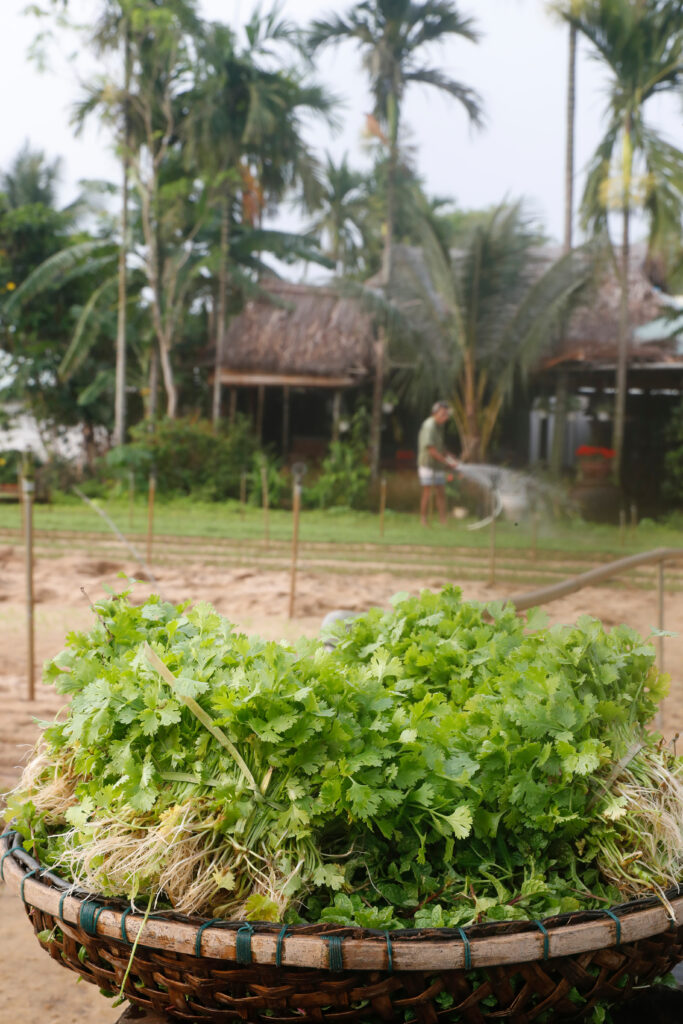
For a deeper understanding of Vietnamese herbs, take part in a cooking class or visit an herb farm. These experiences provide hands-on learning and a chance to see how herbs are cultivated and used.
- Cooking Classes: Many culinary schools and local chefs in Vietnam offer cooking classes that highlight the use of herbs. In Hoi An, Red Bridge Cooking School includes a guided market tour where you can pick fresh herbs before learning to cook dishes like Pho and fresh spring rolls.
- Herb Farms: Visit a traditional herb village like Tra Que Vegetable Village in Hoi An, where you can learn about organic farming techniques and the role of herbs in Vietnamese cuisine. You can even try your hand at planting and harvesting.
These experiences not only teach you how to use herbs but also connect you to the farmers and cooks who keep Vietnam’s culinary traditions alive.
Street Food Tours
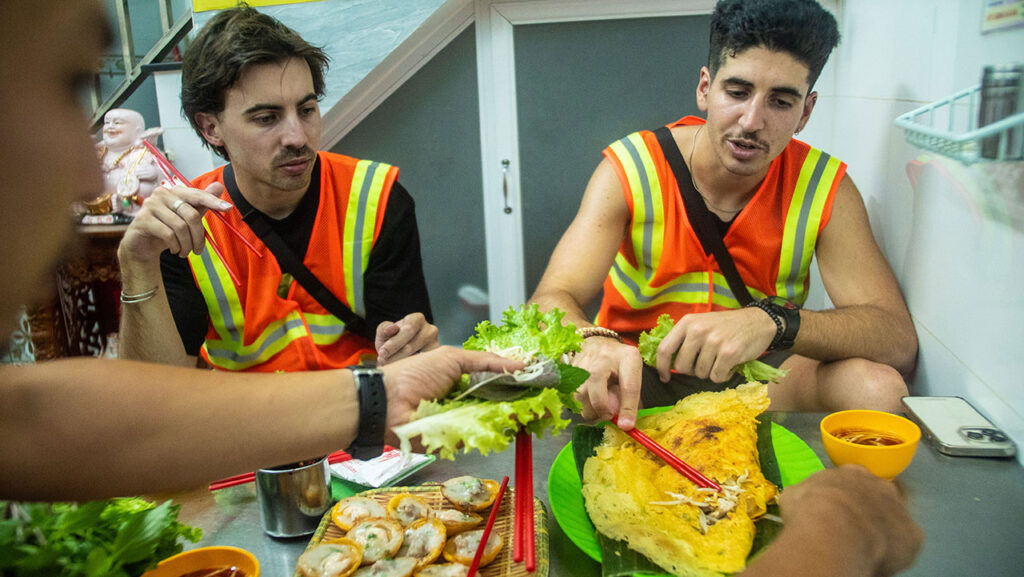
Street food tours are an excellent way to experience how herbs elevate everyday dishes in Vietnam. Guided by local experts, you’ll discover hidden gems and taste authentic recipes brimming with herbal flavors.
- Hanoi: A street food tour in Hanoi might include stops for Bun Cha and Pho, showcasing herbs like perilla, mint, and Thai basil.
- Hoi An: Join a food tour to sample local specialties like Cao Lau and Banh Mi, where herbs play a supporting but essential role.
- Ho Chi Minh City: Explore the bustling streets of Saigon with a guide who can introduce you to dishes like Banh Xeo and Goi Cuon, accompanied by fragrant herbs like coriander and Vietnamese mint. For an unforgettable experience, try the Saigon Foodie Night Ride by Jackfruit Adventure, where you’ll not only savor these iconic dishes but also enjoy the lively nighttime atmosphere and the hidden gems of the city
These tours not only satisfy your taste buds but also offer insights into how herbs are seamlessly woven into the tapestry of Vietnamese street food.
From the markets to the farms and the streets, Vietnam offers countless opportunities to explore its herbal heritage. Whether you’re shopping for fresh greens, learning traditional recipes, or tasting street food, you’ll come away with a deeper appreciation for the role herbs play in Vietnamese culture and cuisine.
Embracing Vietnamese Herbs
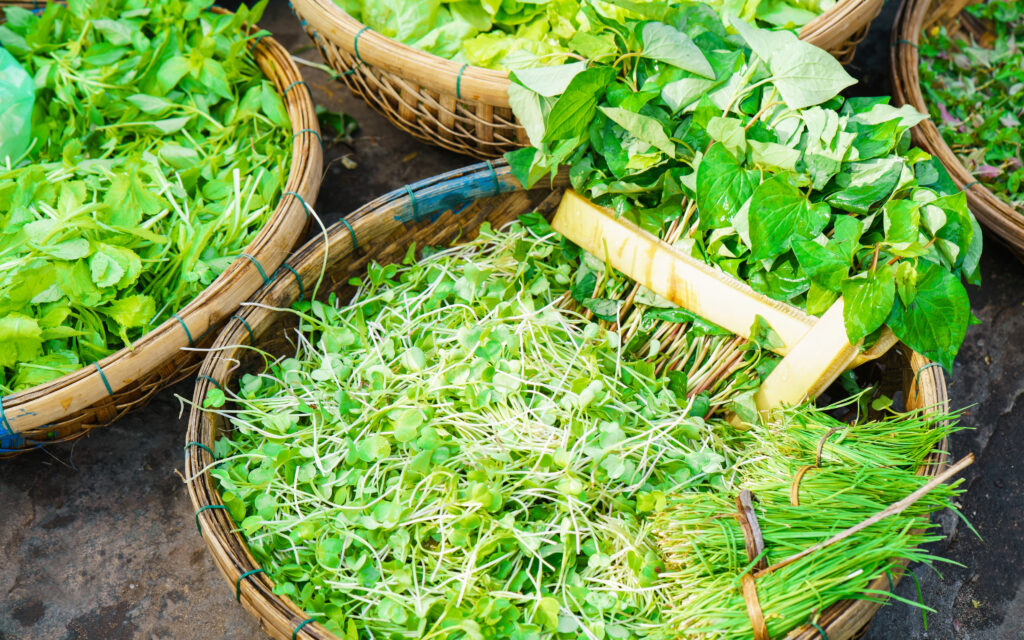
Vietnamese herbs are more than just ingredients; they are the heart and soul of a cuisine that harmonizes flavor, health, and culture. From the zesty punch of Thai basil to the soothing freshness of mint, these herbs bring life to every dish, offering a sensory journey that reflects the deep-rooted traditions and values of Vietnamese culinary artistry.
For those traveling to Vietnam, immersing yourself in the local herb culture,whether through bustling markets, aromatic street food tours like Ho Chi Minh Cycling tour is an unforgettable experience. For those at home, incorporating Vietnamese herbs into your cooking can be a way to savor a slice of Vietnam’s vibrant culinary heritage.
So why not embark on a flavorful journey of discovery? Whether you’re uncovering Vietnam’s must-try dishes or hunting for hidden food gems in Ho Chi Minh City, let the magic of Vietnamese herbs enrich your travels and taste buds.
Related Articles You’ll Love:
Let these articles guide your adventure into the delicious world of Vietnamese cuisine!
- Top 10 Vietnamese Healthy Dishes You Should Try
- Explore Saigon’s Best Dessert Shops: A Guide to Che
- Ho Chi Minh City Street Food: A Guide to the Best Eats
- Nightlife Enjoy Street Food at Phung Hung Market
- Vietnamese Dipping Sauce
For more ways to explore Vietnam and its dynamic cities, check out our other articles:
- 25 unusual things to do in Ho Chi Minh
- 12 must-do tours in Ho Chi Minh
- 26 highlights in Ho Chi Minh’s Chinatown
- 20 Things To Do In Ho Chi Minh City At Night
- 25 Things to Do with Kids in Ho Chi Minh City
Ho Chi Minh City Cycling Tour In Ho Chi Minh City (Saigon) – Vietnam

At Jackfruit Adventure, we organize Ho Chi Minh City Cycling Tour and Team Building Ho Chi Minh. With a deep knowledge of Saigon city and local connections, we believe we can give you an awesome bonding time together. Contact us today if you have any requests or questions to prepare a trip for your team to bond in Ho Chi Minh – Vietnam.




